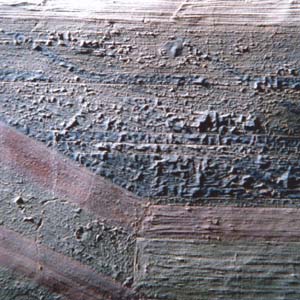 |
|
|
 |
| Poor cohesion is related to crystallisation
of soluble salts |
 |
Poor adhesion
and cohesion of the paint film
This is mainly due to processes of crystallisation
of soluble salts in the superficial layers of the plaster
or immediately below the painted surfaces "a secco".
In some areas, the situation is aggravated by the fact that
the paint film is impregnated with consolidating agents, both
natural and synthetic, applied during previous restoration
work, in rather high concentration or quantity (see residues
of consolidating agents). There are also clear signs of de-cohesion
of the dark blue pigments and sometimes the red ones, applied
"a secco", mainly due to the denaturation of the
organic binder, and often associated with a thinning of the
painted layers (see abrasions on the paint film).
|
|
|
Poor adhesion
of the preparatory layers
While checking the loss of adhesion between the preparatory
layers and the masonry, some serious and quite serious defects
were recorded, ignoring those of a low level which were not
in a precarious situation in terms of conserving the plaster,
and whose consolidation was not particularly urgent.
|
|
| |
|
Poor cohesion
in the preparatory layers
The problem of rainwater infiltration was solved by
consolidating and repairing the Chapel walls during the 20th
century. Subsequently, problems of cohesion seem to be wholly
related to the crystallisation of soluble salts (see formation
of saline deposits) and only occur in the surface layers of
the plaster.
|
|
| |
|
Pre-existing
stucco work
These differ according to the various materials used,
the granular composition, the depth of the layer and the finishing
of the surface. Such diversity depends not only on the period
when they were carried out but also on the size of the area
of missing plaster to be filled. There are three main types
of stucco work: those done with soft mortar, those done with
hydraulic mortar (which also includes the very large number
of filled nail holes) and those done with a type of putty
based on synthetic resin. The majority of the stucco work
was finished with a neutral tint, though there are several
examples of pictorial imitation on the large-scale lacunas
especially in the areas of the dark-blue sky, the "Cosmati-style"
decorations on the cornices, and parts of the imitation marble
along the foot of the walls.
|
|
| |
|
Poor adhesion
and lacunas in the metal laminas
As for the painted surfaces, degradation is related,
though to a lesser extent, to the presence of saline deposits,
as well as to previous damage caused by infiltration of moisture.
|
|
|
|
|
|
|












